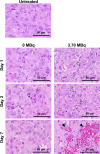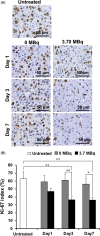Therapeutic efficacy evaluation of radioimmunotherapy with 90 Y-labeled anti-podoplanin antibody NZ-12 for mesothelioma
- PMID: 30801908
- PMCID: PMC6500970
- DOI: 10.1111/cas.13979
Therapeutic efficacy evaluation of radioimmunotherapy with 90 Y-labeled anti-podoplanin antibody NZ-12 for mesothelioma
Abstract
Podoplanin is a type I transmembrane sialomucin-like glycoprotein that is highly expressed in malignant mesothelioma. The rat-human chimeric antibody NZ-12 has high affinity for human podoplanin and antibody-dependent cellular cytotoxicity and is applicable for radioimmunotherapy (RIT) to enhance the antitumor effect. In the present study, we evaluated the in vivo and in vitro properties of radiolabeled NZ-12 and the antitumor effect of RIT with 90 Y-labeled NZ-12 in an NCI-H226 (H226) malignant mesothelioma xenograft mouse model. 111 In-labeled NZ-12 bound specifically to H226 cells with high affinity, and accumulation was high in H226 tumors but low in major organs. RIT with 90 Y-labeled NZ-12 significantly suppressed tumor growth and prolonged survival without body weight loss and obvious adverse effects. Higher podoplanin expression levels were observed in human mesothelioma specimens, suggesting higher tumor accumulation of 90 Y-labeled NZ-12 in patients compared with the H226 tumor xenografts. Our findings suggest that 90 Y-labeled NZ-12 is a promising RIT agent as a new therapeutic option for malignant mesothelioma that warrants further clinical studies to evaluate the dosimetry and efficacy in patients.
Keywords: antibody; malignant mesothelioma; podoplanin; radiation; radioimmunotherapy.
© 2019 The Authors. Cancer Science published by John Wiley & Sons Australia, Ltd on behalf of Japanese Cancer Association.
Conflict of interest statement
Authors declare no conflicts of interest for this article.
Figures







Similar articles
-
Preclinical Evaluation of Podoplanin-Targeted Alpha-Radioimmunotherapy with the Novel Antibody NZ-16 for Malignant Mesothelioma.Cells. 2021 Sep 22;10(10):2503. doi: 10.3390/cells10102503. Cells. 2021. PMID: 34685483 Free PMC article.
-
Antitumor effect of novel anti-podoplanin antibody NZ-12 against malignant pleural mesothelioma in an orthotopic xenograft model.Cancer Sci. 2016 Sep;107(9):1198-205. doi: 10.1111/cas.12985. Epub 2016 Aug 25. Cancer Sci. 2016. PMID: 27294401 Free PMC article.
-
A novel targeting therapy of malignant mesothelioma using anti-podoplanin antibody.J Immunol. 2013 Jun 15;190(12):6239-49. doi: 10.4049/jimmunol.1300448. Epub 2013 May 20. J Immunol. 2013. PMID: 23690472
-
The role of nuclear medicine in the treatment of non-Hodgkin's lymphoma (NHL).Leuk Lymphoma. 2003;44 Suppl 4:S29-36. doi: 10.1080/10428140310001616935. Leuk Lymphoma. 2003. PMID: 15154740 Review.
-
Radioimmunotherapy of infectious diseases.Semin Nucl Med. 2009 Mar;39(2):146-53. doi: 10.1053/j.semnuclmed.2008.10.007. Semin Nucl Med. 2009. PMID: 19187806 Free PMC article. Review.
Cited by
-
Medical application of the monoclonal antibody SKM9-2 against sialylated HEG1, a new precision marker for malignant mesothelioma.Proc Jpn Acad Ser B Phys Biol Sci. 2023;99(2):39-47. doi: 10.2183/pjab.99.003. Proc Jpn Acad Ser B Phys Biol Sci. 2023. PMID: 36775341 Free PMC article. Review.
-
Preclinical Evaluation of Podoplanin-Targeted Alpha-Radioimmunotherapy with the Novel Antibody NZ-16 for Malignant Mesothelioma.Cells. 2021 Sep 22;10(10):2503. doi: 10.3390/cells10102503. Cells. 2021. PMID: 34685483 Free PMC article.
-
Lung Pneumonitis and Fibrosis in Cancer Therapy: A Review on Cellular and Molecular Mechanisms.Curr Drug Targets. 2022;23(16):1505-1525. doi: 10.2174/1389450123666220907144131. Curr Drug Targets. 2022. PMID: 36082868 Review.
-
FZD10-targeted α-radioimmunotherapy with 225 Ac-labeled OTSA101 achieves complete remission in a synovial sarcoma model.Cancer Sci. 2022 Feb;113(2):721-732. doi: 10.1111/cas.15235. Epub 2021 Dec 21. Cancer Sci. 2022. PMID: 34935247 Free PMC article.
-
Targeted Phototherapy for Malignant Pleural Mesothelioma: Near-Infrared Photoimmunotherapy Targeting Podoplanin.Cells. 2020 Apr 20;9(4):1019. doi: 10.3390/cells9041019. Cells. 2020. PMID: 32326079 Free PMC article.
References
-
- Robinson BW, Lake RA. Advances in malignant mesothelioma. N Engl J Med. 2005;353(15):1591‐1603. - PubMed
-
- Sterman DH, Albelda SM. Advances in the diagnosis, evaluation, and management of malignant pleural mesothelioma. Respirology. 2005;10(3):266‐283. - PubMed
-
- Vogelzang NJ, Rusthoven JJ, Symanowski J, et al. Phase III study of pemetrexed in combination with cisplatin versus cisplatin alone in patients with malignant pleural mesothelioma. J Clin Oncol. 2003;21(14):2636‐2644. - PubMed
MeSH terms
Substances
Grants and funding
LinkOut - more resources
Full Text Sources
Medical

